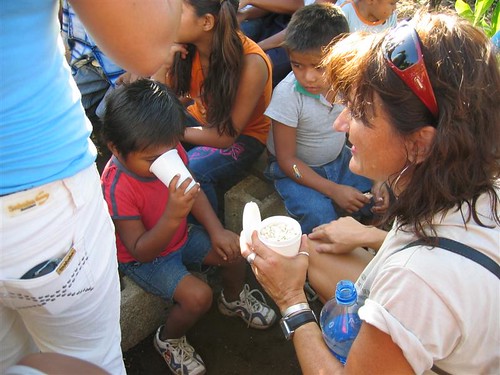
This one’s for Glenna.
There are lots of ways you can prevent or cure malnutrition. They come down to emergency feeding, supplementation, fortification, and changing food behaviors. Here’s a high-speed tour, in order of speed of impact and sexiness to donors.
Therapeutic foods come in two forms: powders that are mixed with clean water to become nutritional formulas, and ready-to-use therapeutic foods. Both are used as emergency measures, the tools of last resort to prevent death. You need to target them in a very specific way to use them well. Formulas are starting to be supplanted by the very trendy plumpy’nut, which can be used without a doctor’s attention once distributed. Some malnourished people are still so bad off that they need formula, though.
When you need therapeutic foods, something has already gone wrong. They are a patch for a broken system. A clear example of a downstream solution. Quick to get started, rapid results, no real long term impact. Very very sexy to donors, since feeding starving children is exactly the thing people think about when they picture aid work and projects get going fast.
Vitamin supplements don’t need to be heavily targeted, but you can’t just give them out to everyone. Different categories of people – children, pregnant women, and so on – need different nutritional supplements. Not a ton of supervision is needed, but some. In addition to targeting, someone has to physically give them out. Supplements need a health system, or at least a logistical system, behind them. Somewhat exciting for donors, since programs gear up fast and little children line up adorably to get their vitamins.
Food fortification doesn’t need a logistical system or medical support. If you get iron and folic acid into the flour, iodine into the salt, and vitamin E into the oil, you can improve the nutritional status of an entire population. But you end up supplementing a whole lot of people who don’t need it. It’s effective, but it’s not efficient. You also need a government capable of enforcing fortification, so it’s an upstream solution. And we’re starting to see some evidence that some kinds of fortification, like folic acid, can increase some kinds of cancer, so they are not an unqualified good. Fortification is boring for donors. They details and politics of fortification are honestly pretty boring for nutrition experts, let alone people trying to decide where to give their twenty bucks or overworked government types.
Lastly, changing food behavior involves teaching people how to eat in a way that meets their nutritional needs. The classic examples are not selling home-grown vegetables and using the money to buy processed foods, and increasing the consumption of legumes, especially in combination with leafy greens. So many things affect individual eating behavior that this is an upstream and a downstream solution. It’s about what is available to eat, and what people choose from that. Changing nutrition behaviors is very, very hard. It takes a long time and shows its impact slowly. It’s downright repulsive to donors, because it reminds everyone of all the vegetables they ought to be eating themselves.
*******
Chosen for reasons I hope are obvious.

“Changing nutrition behaviors is very, very hard. It takes a long time and shows its impact slowly. It’s downright repulsive to donors, because it reminds everyone of all the vegetables they ought to be eating themselves.”
Beautifully put. One of my favorite development projects anywhere is outside Goma in the DRC. A bunch of unemployed Congolese agronomists got together, got a farm, and started experimenting with ways to grow veggies in very rocky volcanic soil. They’re doing exactly what the donors hate, slowly growing food, teaching widows and rape victims how to do the same, and changing nutrition behaviors year by year by year. And it works.
Reminds me of discussions I had with my mother, a nurse in a big hospital in a small Nigerian town. Because of the location of the hospital it often attracts mothers from nearby, poor villages….It is amazing how much nutritional harm is due to poor nutritional behaviour, and how much can be changed by encouraging them to change the feeding habits of their children.
Thanks for this.
Loomnie.
Healthy eating habits and sustainable local agriculture are clearly the long term goals and should be supported wherever possible. But as you say changing behaviours is very hard. Indeed it’s perhaps not possible for everyone, even in developed countries where choices and information about them are plentiful.
Vitamin supplements and food fortification do have strong economic evidence in their favour in terms of cost effectiveness, even with the inefficiencies you mention and so make a lot of sense as public health interventions in both developed and developing countries (typed while eating a bowl of fortified breakfast cereal, topped with fortified milk)
Changing nutritional behavior is indeed a formidable task especially when you are ill-equipped to deal with the situation. How can you teach people to eat the right things at the right amount when putting food on the table is the real challenge.